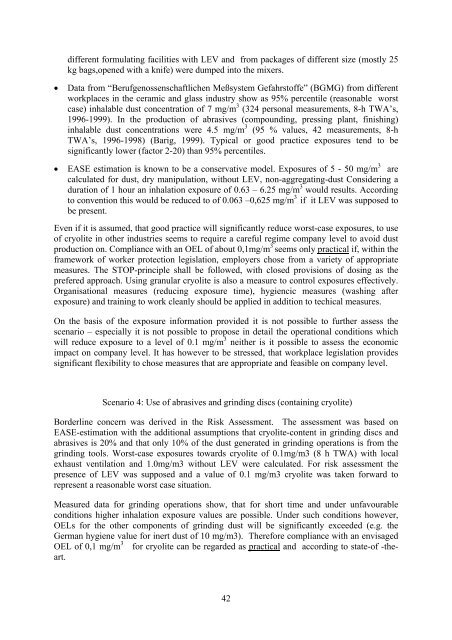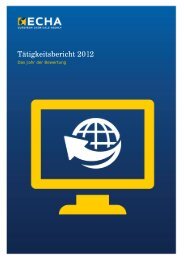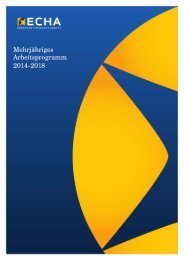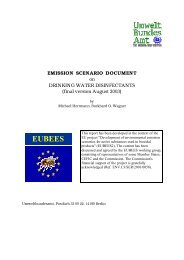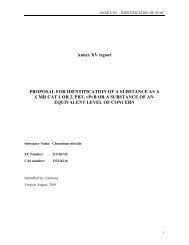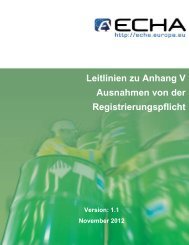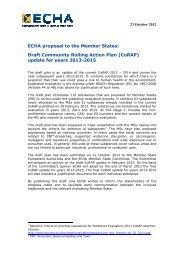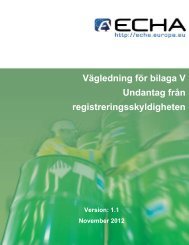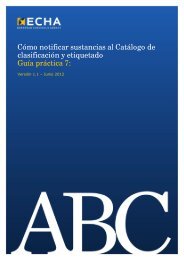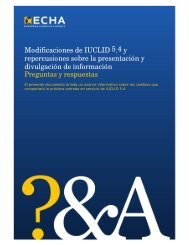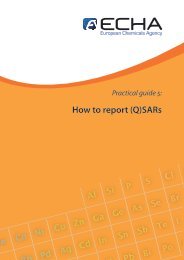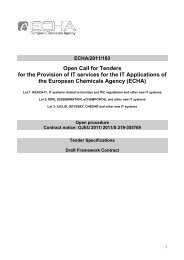Strategy For Limiting Risks Human Health Draft of ... - ECHA - Europa
Strategy For Limiting Risks Human Health Draft of ... - ECHA - Europa
Strategy For Limiting Risks Human Health Draft of ... - ECHA - Europa
Create successful ePaper yourself
Turn your PDF publications into a flip-book with our unique Google optimized e-Paper software.
different formulating facilities with LEV and from packages <strong>of</strong> different size (mostly 25<br />
kg bags,opened with a knife) were dumped into the mixers.<br />
• Data from “Berufgenossenschaftlichen Meßsystem Gefahrst<strong>of</strong>fe” (BGMG) from different<br />
workplaces in the ceramic and glass industry show as 95% percentile (reasonable worst<br />
case) inhalable dust concentration <strong>of</strong> 7 mg/m 3 (324 personal measurements, 8-h TWA’s,<br />
1996-1999). In the production <strong>of</strong> abrasives (compounding, pressing plant, finishing)<br />
inhalable dust concentrations were 4.5 mg/m 3 (95 % values, 42 measurements, 8-h<br />
TWA’s, 1996-1998) (Barig, 1999). Typical or good practice exposures tend to be<br />
significantly lower (factor 2-20) than 95% percentiles.<br />
• EASE estimation is known to be a conservative model. Exposures <strong>of</strong> 5 - 50 mg/m 3 are<br />
calculated for dust, dry manipulation, without LEV, non-aggregating-dust Considering a<br />
duration <strong>of</strong> 1 hour an inhalation exposure <strong>of</strong> 0.63 – 6.25 mg/m 3 would results. According<br />
to convention this would be reduced to <strong>of</strong> 0.063 –0,625 mg/m 3 if it LEV was supposed to<br />
be present.<br />
Even if it is assumed, that good practice will significantly reduce worst-case exposures, to use<br />
<strong>of</strong> cryolite in other industries seems to require a careful regime company level to avoid dust<br />
production on. Compliance with an OEL <strong>of</strong> about 0,1mg/m 3 seems only practical if, within the<br />
framework <strong>of</strong> worker protection legislation, employers chose from a variety <strong>of</strong> appropriate<br />
measures. The STOP-principle shall be followed, with closed provisions <strong>of</strong> dosing as the<br />
prefered approach. Using granular cryolite is also a measure to control exposures effectively.<br />
Organisational measures (reducing exposure time), hygiencic measures (washing after<br />
exposure) and training to work cleanly should be applied in addition to techical measures.<br />
On the basis <strong>of</strong> the exposure information provided it is not possible to further assess the<br />
scenario – especially it is not possible to propose in detail the operational conditions which<br />
will reduce exposure to a level <strong>of</strong> 0.1 mg/m 3 neither is it possible to assess the economic<br />
impact on company level. It has however to be stressed, that workplace legislation provides<br />
significant flexibility to chose measures that are appropriate and feasible on company level.<br />
Scenario 4: Use <strong>of</strong> abrasives and grinding discs (containing cryolite)<br />
Borderline concern was derived in the Risk Assessment. The assessment was based on<br />
EASE-estimation with the additional assumptions that cryolite-content in grinding discs and<br />
abrasives is 20% and that only 10% <strong>of</strong> the dust generated in grinding operations is from the<br />
grinding tools. Worst-case exposures towards cryolite <strong>of</strong> 0.1mg/m3 (8 h TWA) with local<br />
exhaust ventilation and 1.0mg/m3 without LEV were calculated. <strong>For</strong> risk assessment the<br />
presence <strong>of</strong> LEV was supposed and a value <strong>of</strong> 0.1 mg/m3 cryolite was taken forward to<br />
represent a reasonable worst case situation.<br />
Measured data for grinding operations show, that for short time and under unfavourable<br />
conditions higher inhalation exposure values are possible. Under such conditions however,<br />
OELs for the other components <strong>of</strong> grinding dust will be significantly exceeded (e.g. the<br />
German hygiene value for inert dust <strong>of</strong> 10 mg/m3). Therefore compliance with an envisaged<br />
OEL <strong>of</strong> 0,1 mg/m 3 for cryolite can be regarded as practical and according to state-<strong>of</strong> -theart.<br />
42


